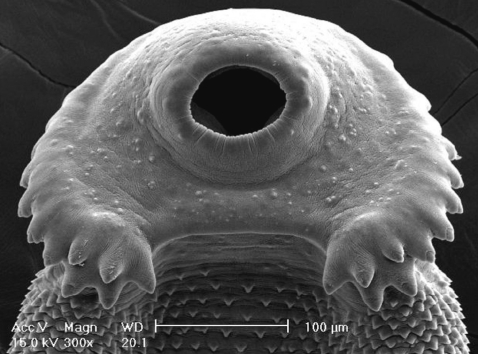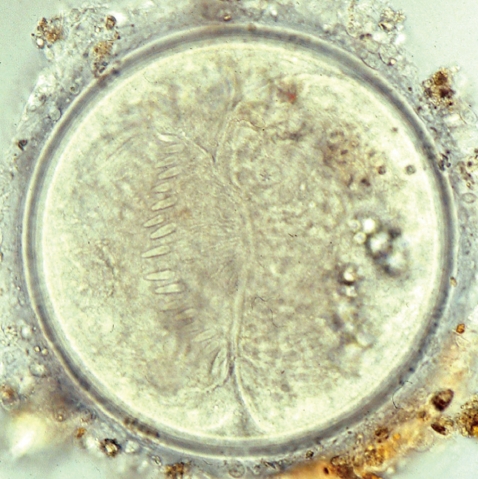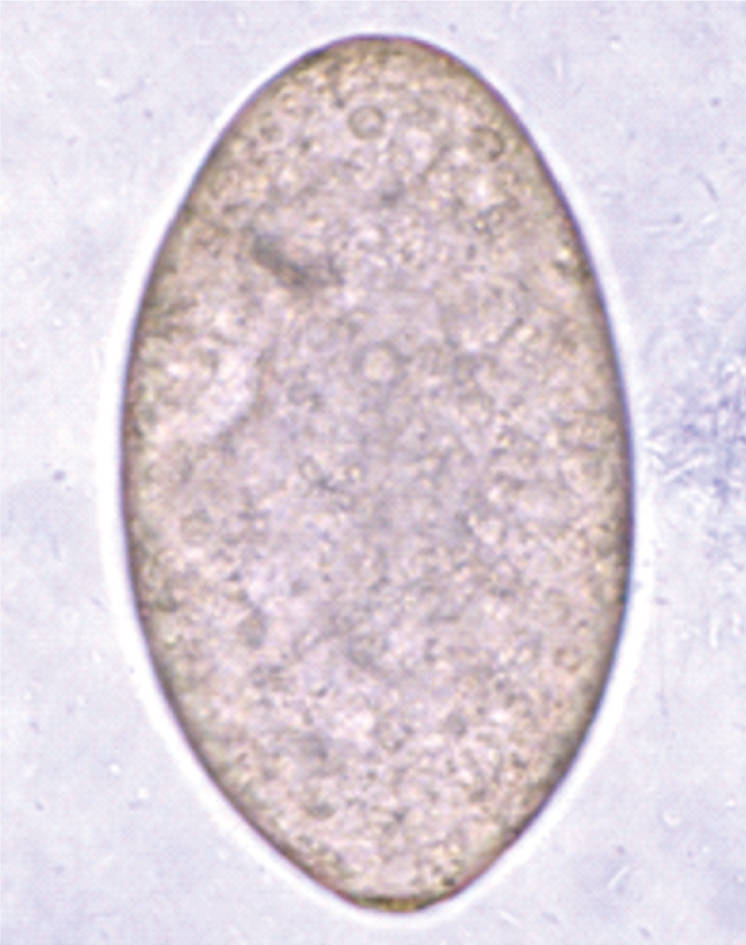Echinostoma revolutum: Metacercariae in Filopaludina Snails from Nam Dinh Province, Vietnam, and Adults from Experimental Hamsters
Article information
Abstract
We detected metacercariae of Echinostoma revolutum in Filopaludina sp. snails purchased from a local market in Nam Dinh Province for the first time in Vietnam. Adult flukes were harvested from experimentally infected hamsters at days 14 and 17 post-infection. The metacercariae were round, 170-190 µm (n=15) in diameter, with a cyst wall thickness of about 12 µm. A total of 37 collar spines were arranged around the head collar, and large excretory granules were seen in 2 canals of the excretory bladder. The 14-day old adult flukes were elongated, ventrally curved, and 5.0-7.2×0.8-1.3 mm (n=20). The head collar had a total of 37 collar spines arranged in 2 alternating rows, including 5 corner spines on each side. The cirrus sac contained a saccular seminal vesicle, a prostatic gland, and an unarmed cirrus. Two tandem testes were smooth or slightly lobed. Eggs were ovoid to elliptical, 110-118×70-75 µm. These morphological characters were similar to those of E. revolutum and E. jurini. We tentatively identified it as E. revolutum because the validity of E. jurini remains to be elucidated. The taxonomic relationship of E. revolutum and E. jurini is discussed.
Echinostomes (=family Echinostomatidae) are intestinal flukes of birds and mammals, including humans [1,2]. In heavy infections, they can cause mucosal ulceration, bleeding, and severe inflammation in human patients. To date, 20 species of zoonotic echinostomes belonging to 9 genera have been discovered worldwide (Echinostoma, Echinochasmus, Acanthoparyphium, Artyfechinostomum, Echinoparyphium, Episthmium, Himasthla, Hypoderaeum, and Isthmiophora) [1]. Among them, Echinostoma is the most important and 7 zoonotic species of Echinostoma are known; Echinostoma revolutum, E. angustitestis, E. cinetorchis, E. echinatum, E. hortense, E. ilocanum, and E. macrorchis [1].
E. revolutum (Froelich, 1802) Looss, 1899 was the first echinostome species described in the literature [1]. It was first discovered as an intestinal fluke of ducks but is now known to infect a variety of avian and mammalian species, including geese, muskrats, and humans [1-3]. E. revolutum is found worldwide, including Asia, Europe, Africa, Australia, New Zealand, and the Americas [1]. In Asia, E. revolutum has been reported from China, Taiwan, Korea, Japan, Indonesia, Malaysia, Thailand, India, Russia, and Cambodia [1-6]. Vietnam was among the list of countries where E. revolutum was distributed [6]. However, it was based upon a suggestion on the presence of the larval stage, Cercaria spinifera [7]. No other detailed information about this echinostome in Vietnam is available. In the present study, we purchased Filopaludina sp. snails from a local market in Nam Dinh Province, Vietnam and examined them for the presence of echinostome metacercariae. We detected metacercariae and identified them as E. revolutum through recovery of adult flukes from experimental hamsters.
Filopaludina sp. snails (Fig. 1) were purchased from a local market in Nam Dinh Province, Vietnam in April 2005 and transferred to our laboratory (Gyeongsang National University, Jinju, the Republic of Korea) on ice. They (n=30) were divided into 6 groups, crushed with their shells using a mortar and pestle, and digested for 2 hr in pepsin-HCl solution. A total of 450 metacercariae from 30 snails (15 per snail) were collected in the digested material using a stereomicroscope. Metacercariae were examined morphologically and measured using a light microscope. Three ducks were orally infected with 100 metacercariae each and 2 hamsters were orally infected with 50 metacercariae each. A total of 35 adult flukes were recovered from the small intestine of the 2 hamsters (average recovery; 35%) at days 14 and 17 post-infection (PI). No worms were recovered from the the ducks. Twenty adult worms were fixed with 10% neutral buffered formalin under coverslip pressure, stained with Semichon's acetocarmine, and measured using a light microscope.
To observe the surface ultrastructure, some of the adult worms were washed several times with 0.2 M cacodylate buffer (pH 7.2) and fixed with 2.5% glutaraldehyde at 4℃. After washing 3 times with the buffer, they were dehydrated through a graded ethanol series (50%, 70%, 80%, 90%, 95%, and absolute alcohol), dried in a critical point dryer, coated with gold (JFC-1100E ion sputtering device), and examined with a scanning electron microscope (SEM) (Philips XL-30S) at an accelerating voltage of 20 kV.
The metacercarial cyst was almost spherical and 170-190 µm in diameter, with a thick outer wall of about 12 µm and a thin inner opaque wall of about 3 µm (Fig. 2). They had characteristically large, round excretory granules in 2 descending canals of the main excretory bladder. Collar spines, 37 in total, were clearly visible around the head collar, with 5 corner spines on each side and 27 ventral, lateral, and dorsal spines, in 2 alternating rows (Fig. 2). The metacercariae were detected mainly in the pericardial sac of the snail.
The adult flukes were elongated, ventrally curved, and 5.0-7.2×0.8-1.3 mm (n=20) (Fig. 3). Eggs were operculated, elliptical, with a small abopercular wrinkle or thickening, and 110-118×70-75 µm (n=20) (Fig. 4). The head collar of the adult was distinct, bearing 37 collar spines arranged in 2 alternating rows, including 5 corner spines on each side. The oral sucker was subterminal. The prepharynx was very short, and the pharynx was well developed. The esophagus was somewhat long. The cirrus sac was well developed, containing a saccular seminal vesicle and an unarmed cirrus. The ventral sucker was round and moderately large. The ovary was transversely elliptical and located on the median line of the body. Testes were tandom, smooth or slightly lobed.

Adult worm (7.0×1.1 mm) of E. revolutum experimentally obtained from a hamster at day 14 post-infection.
In SEM observations, the adult flukes were elongated and leaf-like, with a distinct head collar and oral sucker anteriorly, and a ventrally protruding ventral sucker near the anterior 1/5 region of the body (Figs. 5-7). The tegument of the anterior region of the body was densely covered with scale-like spines (Figs. 5-7). The tegumental spines became sparse toward the posterior part of the body. There were numerous ciliated or aciliated sensory papillae distributed around the oral sucker and head collar (Fig. 6). The arrangement of the collar spines, including the 5 corner spines, was clearly visible. The corner spines were characteristically arranged in 2 rows, 3 oral and 2 aboral, on each side (Fig. 6). Small, scale-like tegumental spines were distributed on the surface around the ventral sucker (Fig. 7). On the lip of the ventral sucker, many sensory papillae were distributed. The cirrus was seen to have protruded out of the cirrus sac.

Scanning electron microscopic (SEM) views of E. revolutum adults. Ventral view of a whole worm showing its elongated and leaf-like appearance, with a distinct head collar, and oral and ventral suckers.

Scanning electron microscopic (SEM) views of E. revolutum adults. The lip of the ventral sucker covered by many sensory papillae. An unarmed cirrus is seen protruded from the cirrus sac.

Scanning electron microscopic (SEM) views of E. revolutum adults. The tegument around the oral sucker and head collar showing its smooth surface and numerous sensory papillae and the characteristic arrangement of the collar spines, including the 5 corner spines. The tegument posterior to the head collar is covered with scale-like spines.
The results of this study indicated that the life cycle of E. revolutum is mainained in Vietnam, using Filopaludina snails or other species of freshwater molluscs or amphibians as the second intermediate host. Eating raw or improperly cooked snails may cause human echinostomiasis which should be verified through epidemiological surveys and clinical interventions in Vietnam.
There was a taxonomic problem in identifying our specimens because of the complexity in the systematics of 37-collar-spined echinostomes, the so-called 'revolutum' group [8,9]. Within this group, more than 30 species have been described. However, at present, only 12 species, E. revolutum (Froelich, 1802) [1,6,9], E. caproni Richard, 1964 [9-11], E. cinetorchis Ando and Ozaki, 1924 [1,12]; E. deserticum Kechemir et al., 2002 [9,13], E. echinatum (Zeder, 1803) [14-16], E. friedi Toledo et al., 2000 [9,17], E. jurini (Skvortsov, 1924) [9,18], E. luisreyi Maldonado et al., 2003 [9,10], E. miyagawai Ishii, 1932 [9,14], E. paraensei Lie and Basch, 1967 [9,10,19], E. parvocirrus Nassy and Dupouy, 1988 [9,20], and E. trivolvis (Cort, 1914) [9,21], can be considered to be valid [1,2,8,9]. Their differential features, in terms of the life cycle, morphology, and geographical distribution, are reviewed in Table 1.
It is of note that the morphology of the adult flukes is almost indistinguishable between E. revolutum, E. jurini, and E. echinatum, with only several minor differences (Table 1). Kanev et al. [18] compared the differential features of the 3 species and proposed that E. jurini be defined for those that have viviparid snails as the first intermediate host, molluscs, frogs, and freshwater turtles as the second intermediate host, and mammals but not birds as the definitive host. By comparison, E. revolutum have lymnaeid snails as the first intermediate host, molluscs, tadpoles, fish, and freshwater turtles as the second intermediate host, and birds but not mammals as the definitive host [18]. E. echinatum have lymnaeid and planorbid snails as the first intermediate host, gastropods as the second intermediate host, and both birds and mammals as the definitive hosts [18]. Kanev et al. [18] also presented differential points in their cercarial morphology, in particular the numbers of penetration gland cell pores and paraesophageal gland cell pores (Table 1).
In our study, the attempt to infect ducks failed and adult flukes were successfully recovered only from hamsters. The second intermediate host was Filopaludina snails, a viviparid molluscan species. The first intermediate host for our flukes may be the same or different species of viviparid snails, although this was not confirmed in our study. These results are compatible with E. jurini rather than E. revolutum. However, this needs to be clarified through molecular and genetic studies, and the taxonomic significance of E. jurini remains to be elucidated. We herein tentatively designated our specimens as E. revolutum.
Another point that needs to be discussed is the size of the metacercariae. Our metacercariae were 170-190 µm in diameter which is larger than those reported for E. jurini (140-160 µm) [17] and E. echinatum (120-130 µm) [15] (under the name E. lindoensis). With regard to E. revolutum, the metacercarial cyst sizes vary by researchers (117-125 µm by Johnston and Angel [22], 132-152 µm by Kanev [6], 150-160 µm by Tubangui [23], and even 147-220 µm by Zdarska in 1964 as reviewed by Kanev [6]). The size of metacercariae may vary depending on the amount of pressure placed on the cover slip. However, it should be further determined whether all metacercariae within these size range belong to a single taxon of E. revolutum.
Few studies of echinostome flukes have been performed in Vietnam. Kanev [6] studied Cercaria spinifera (presumed to be E. revolutum) in Central Europe and other areas and suggested the possible presence of E. revolutum in Vietnam. Recently, metacercariae of Echinochasmus japonicus were reported from a species of freshwater fish, Labeo rohita in Vietnam [24]. In addition, 2 types of echinostome cercariae (species undetermined) were detected from several species of freshwater snails in Nam Dinh Province, Vietnam [25]. The Type 2 cercariae [25] detected from Gyraulus convexiusculus snails may be those of Echinostoma sp. based on the size and the photo presented. However, this identification needs to be clarified.
Regarding the surface topography of E. revolutum adults, there has been surprisingly little documentation. There is one report which focused on the collar region [26]. Although several ultrastructural studies were performed on what was thought to be E. revolutum [27,28], the echinostomes studied were later determined to be E. trivolvis [26]. The surface ultrastructure of the collar region of E. revolutum appeared to be basically the same in our study and that of Kanev et al. [26]. In particular, the end group and lateral group collar spines were almost identical. However, our adult flukes were obtained from experimental hamsters (mammal) whereas those in Kanev et al. [26] were harvested from chickens (birds) [26]. Therefore, the taxonomic issue needs to be further clarified on our observed worms.
ACKNOWLEDGMENT
This study was supported by the National Foundation for Science and Technology Development (NAFOSTED) in Vietnam.



